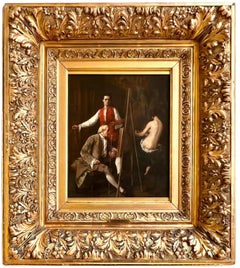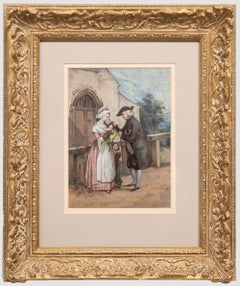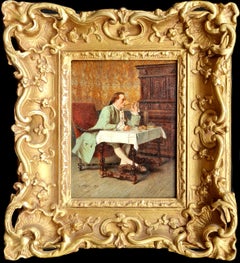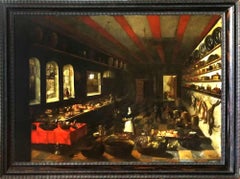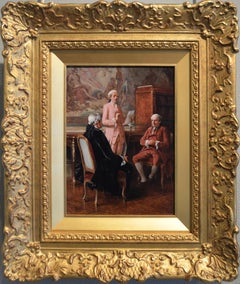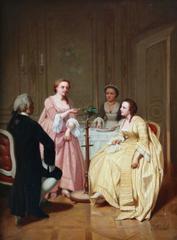Benjamin Eugène Fichel Art
to
1
2
2
4
1
The Painter and His Muse
By Benjamin Eugène Fichel
Located in Wiscasett, ME
Oil on panel signed in the lower right corner and presented in a period frame measuring 21" x 18.5".
Provenance:
Private Collection
Bradbury Art and Antiques, Wiscasset, ME
Benj...
Category
19th Century Baroque Benjamin Eugène Fichel Art
Materials
Oil
Benjamin Eugene Fichel (1826-1895) - Late 19th Century Gouache, God's Children
By Benjamin Eugène Fichel
Located in Corsham, GB
A fine genre scene by the French artist Eugene Benjamin Fichel (1826-1895). 'God's Children'. Watercolour and Gouache. Signed lower right. Well presented in a decorative gilt-effect ...
Category
Late 19th Century Benjamin Eugène Fichel Art
Materials
Gouache
"The Painter and His Muse" Painting by Eugène Benjamin Fichel
By Benjamin Eugène Fichel
Located in Wiscasset, ME
Oil on panel signed in the lower right corner and presented in a period frame measuring 21" x 18.5".
Benjamin Eugene Fichel, France, (1826 - 1895)
B. Eugène Fichel was born on Au...
Category
19th Century French Baroque Antique Benjamin Eugène Fichel Art
Materials
Paint
A Fine Wine
By Benjamin Eugène Fichel
Located in Belgravia, London, London
Oil on panel
Panel size: 7 x 5 inches
Signed and date '1859' lower left
Category
19th Century Benjamin Eugène Fichel Art
Materials
Oil, Panel
Related Items
Interior Scene with Kitchen - Oil on Canvas - 1659
Located in Roma, IT
Signed and dated lower left.
Includes a beautiful later wooden frame cm. 137x8x182.
Very Good conditions.
Prov. Christie's London, February 15th 1974, n. 19.
This artwork is shippe...
Category
1650s Baroque Benjamin Eugène Fichel Art
Materials
Oil
$57,767
H 45.28 in W 63.78 in D 0.99 in
Sinbad with the Old Man of the Sea on His Back Original Oil Painting
Located in San Francisco, CA
Sinbad with the old man of the sea on his back original illustration oil painting, 19th century.
A fine oil illustration from the Tales of the Ar...
Category
Late 19th Century English Antique Benjamin Eugène Fichel Art
Materials
Canvas
$1,850
H 33.5 in W 29.5 in D 3 in
Circle Teniers, Flemish Art, Peasants smoking and drinking in a Tavern Interior
By David Teniers the Younger
Located in Greven, DE
Circle or Follower of David Teniers, Peasant in a Tavern Inn, drinking and smoking. Oil on canvas, Framed: 39 x 47 cm. Typical Flemish Baroque Interior...
Category
17th Century Baroque Benjamin Eugène Fichel Art
Materials
Canvas, Oil
$2,593
H 13.78 in W 10.63 in
"Smoking Lady" (2024) By Nadezda, Original Oil Painting on Panel
Located in Denver, CO
Nadezda's beautiful new oil on panel painting "Smoking Lady" (2024) is an abstract portrait of a woman wearing a black dress smoking inside of her brightly colored house, she is stan...
Category
2010s Surrealist Benjamin Eugène Fichel Art
Materials
Oil, Panel
Expressionist Figurative water color painting- Series Bath NO.1
Located in Beijing, CN
Artist Biography
Zhang Chunyang was born in 1975 in Changchun, Jilin. She earned her B.F.A at Jilin University of Arts in 1999, and studied at Central Acadamy of Fine Arts, Beijing ...
Category
2010s Expressionist Benjamin Eugène Fichel Art
Materials
Watercolor, Gouache, Handmade Paper
$3,040
H 11.42 in W 14.18 in
Demonstration #1 Hélène Duclos, 21st Century, Contemporary figurative art blue
By Hélène Duclos
Located in Paris, FR
Gouache, coloured pencil and graphite on paper
Signed lower right
Unique work
1 / Hélène DUCLOS, 2016 – Artist Statement
“Questioning the human condition and the position of being ...
Category
21st Century and Contemporary Contemporary Benjamin Eugène Fichel Art
Materials
Paper, Gouache
$4,951
H 25.99 in W 40.16 in D 1.97 in
Thoughtful woman on the terrace of the bar oil on canvas painting
Located in Sitges, Barcelona
Frederic Cabanas (1954) - Pitussi - Oil on canvas
Oil measurements 92x65 cm.
Without frame.
Frederic Cabanas
Multifaceted artist, painter, sculptor, musician, photographer, wr...
Category
1980s Fauvist Benjamin Eugène Fichel Art
Materials
Canvas, Oil
$1,061 Sale Price
43% Off
H 36.23 in W 25.6 in
Fine American Impressionist Interior and Portrait Painting, 1922, Boston area
Located in Baltimore, MD
Born in Cambridge, Massachusetts in 1891, John Gilmore Wolcott graduated from Harvard in 1914 and continued studies in art with Charles Woodbury. He was active in the Boston art scen...
Category
1920s American Impressionist Benjamin Eugène Fichel Art
Materials
Oil
$1,295
H 26 in W 28 in D 2 in
Woman posing oil on canvas painting
Located in Sitges, Barcelona
- Title: *The Model Posing*
- Artist: Rosendo González Carbonell
- Technique: Oil on canvas
- Dimensions: 38.2 x 45.7 in (unframed) ...
Category
1980s Impressionist Benjamin Eugène Fichel Art
Materials
Canvas, Oil
$1,650 Sale Price
53% Off
H 38.19 in W 45.67 in
Woman posing oil on canvas painting
Located in Sitges, Barcelona
Technical Sheet
- Title: *The Secret in Her Eyes*
- Artist: Rosendo González Carbonell
- Technique: Oil on canvas
- Dimensions: 24 x 20 inches
- Framing: Unframed
- Style: Romantic realism...
Category
1980s Expressionist Benjamin Eugène Fichel Art
Materials
Canvas, Oil
$825 Sale Price
30% Off
H 24.02 in W 19.69 in
Original Ronald Shap figure drawing, signed
Located in Columbus, OH
Original oil pastel and gouache figure drawing by celebrated, twentieth-century California landscape painter, Ronald Shap. Sketch of a shirtless man in sun...
Category
1990s Contemporary Benjamin Eugène Fichel Art
Materials
Oil Pastel, Gouache
Painting by Hanoi Artist "The Muse", Red and Black, C 2007, Large Black Frame
Located in New York, NY
Decorative large painting by Hanoi artist, "The Muse", circa 2007.
Category
Early 2000s Vietnamese Modern Benjamin Eugène Fichel Art
Materials
Acrylic
$1,950 Sale Price
20% Off
H 53 in W 41 in D 2 in
Previously Available Items
Genre historical oil painting of three gentlemen
By Benjamin Eugène Fichel
Located in Nr Broadway, Worcestershire
Benjamin Eugene Fichel
French, (1826 -1895)
The Meeting
Oil on panel, signed
Image size: 8.5 inches x 6 inches
Size including frame: 15 inche...
Category
19th Century Victorian Benjamin Eugène Fichel Art
Materials
Oil, Panel
H 15 in W 12.5 in D 2 in
The Novelty
By Benjamin Eugène Fichel
Located in Marlow, Buckinghamshire
A lovely 19th century painting depicting elegant figures in an Interior enjoying a feeding a bird, Oil on Panel. Signed lower right. Provenance, Wiliams & Sons - London
Fichel ent...
Category
19th Century Realist Benjamin Eugène Fichel Art
Materials
Oil, Panel
Making Plans, oil on panel
By Benjamin Eugène Fichel
Located in Nr Broadway, Worcestershire
Benjamin Eugene Fichel
French, (1826 -1895)
Making Plans
Oil on panel, signed & dated 1887
Image size: 14½ inches x 21½ inches
Size inclu...
Category
19th Century Victorian Benjamin Eugène Fichel Art
Materials
Oil, Panel
Benjamin Eugène Fichel art for sale on 1stDibs.
Find a wide variety of authentic Benjamin Eugène Fichel art available for sale on 1stDibs. You can also browse by medium to find art by Benjamin Eugène Fichel in oil paint, paint, panel and more. Not every interior allows for large Benjamin Eugène Fichel art, so small editions measuring 5 inches across are available. Customers who are interested in this artist might also find the work of Leon Richet, Gustave Jean Jacquet, and Fritz Wagner. Benjamin Eugène Fichel art prices can differ depending upon medium, time period and other attributes. On 1stDibs, the price for these items starts at $9,725 and tops out at $9,725, while the average work can sell for $9,725.
